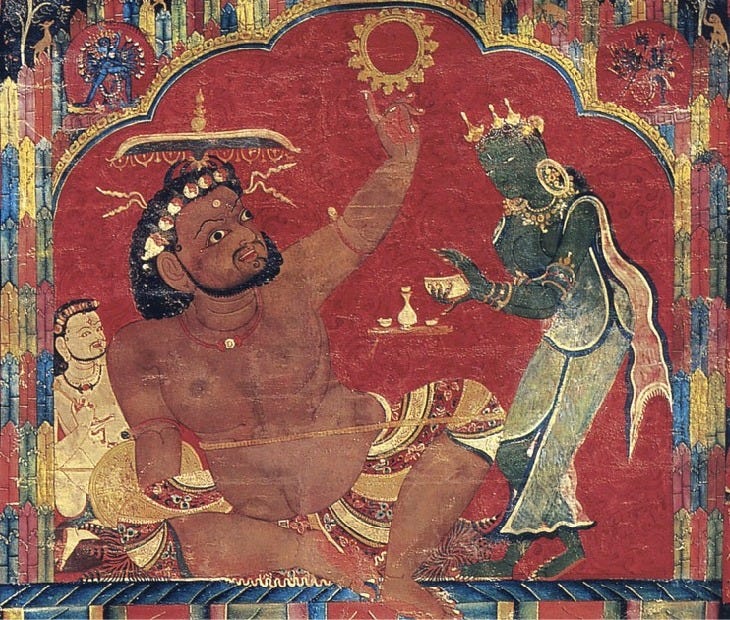The oral instruction of the visualisation of the Amrtasiddhi yoga
English translation by Tsering Dorji
In Tibet, the practice of Amrtasiddhi yoga was systematised into a standard thirty-two trulkhor practice consisting of one preliminary practice (jita-karma), twelve main practices and nineteen secondary practices. There are both abridged and detailed versions of the Amrtasiddhi trulkhor texts in the Shangpa teaching cycles, written by various authors. I have translated the entire text of the detailed version of the Amrtasiddhi trulkhor text in my previous post. Click here to read the text 'Amrtasiddhi thirty-two trulkhor by Virya Simha’
This text 'Oral instruction on visualisation during Amrtasiddhi trulkhor practice' is attributed to Tokden Rinpoche and is found in the Shangpa teaching cycle. As mentioned above, the Amrtasiddhi thirty-two trulkhor consists of preliminary, main and secondary trulkhor practices. This text explains the visualisation practice prior to the preliminary and main trulkhor practices.
If you enjoy my posts and translations and want to fuel more posts, click the button below
TRANSLATION
Namo Guru!
Amrtasiddhi trulkhor’s visualisation consists of a preliminary and a main visualisation.
I. Preliminary visualisation
First of all, sit down on a comfortable seat with your legs crossed and your hands in the meditation posture, and then do the practices of refuge and bodhicitta.
Virupa
Now visualise the root guru Virupa on the crown of your head with a majestic body. He has a reddish-brown complexion. His right forefinger points to the sun in a threatening gesture and pushes the sun upwards. His left hand holds a skullcup filled with Amrta. He is seated with his legs half crossed on the skin of a wild sheep. He wears a bone ornament on his body and a garland of flowers on his head.
Amrtasiddhi lineage masters
Then visualise Tokden Rinpoche on top of Virupa. Then clearly visualise all the Amrtasiddhi lineage masters in ascending order to the source of the Amrtasiddhi teachings as follows: Khetsun Gyaltsen Bum, Khedup Shangton, Sangye Tonpa, Nyenton, Latoe Gonpo, Dhurtroe Nagpo, Dramse Nagpo, Virupa and Vajradhara.
Call out the names of each of the masters with great devotion and make a supplication. Visualise Vajradhra merging into Virupa, and one by one all the masters merging into the root Guru. Say this prayer with fervent devotion, seeing the Guru who is a hundred thousand times more majestic than the sun: 'May my mind dissolve self-grasping, may renunciation arise in me, may I always remember death, may I attain the state of amrta (deathlessness), may all obstacles and hindrances disappear’.
After the supplication, visualise a white syllable ཨ in the form of light in the heart of the Guru. Draw the ཨ-air once and visualise a stream of nectar, like milk, flowing from the ཨ, filling the guru's body, and from his private area, flowing down to the crown of your head. Imagine all obstructive forces, diseases, evil influences and hindrances being purified.
Then the guru dissolves into you. Remain in meditation on that state.
Now expel the residual air three times and carry out the preliminary trulkhors.
II. Main visualisation
Visualise yourself in the form of Vajrayogini and clearly see Vajradhara on the lotus and moon at the heart.
Then meditate the white syllable ཧཾ head facing downward on the crown of your head and the red syllable ཨ almost ready to catch fire in the secret area.
Now, as you exhale, imagine the outer world as five Buddha families, as you inhale, five Buddha families in the form of five colours come to the syllable ཧཾ and dissolve into the syllable ཧཾ.
By pressing the air under the navel, syllable ཨ catches fire. It fills the belly with fire and flows down the stream of the nectar of primordial wisdom from the syllable ཧཾ at the crown. At the heart, the nectar enters the mouth of the guru and infuses the body with the bliss that is free from karmic flow.
And now carry out the main trulkhor practices.
III. Colophon
The oral instruction of the visualisation of the Amrtasiddhi trulkhor is written by Tokden Rinpoche without addition or omission as received from the mouth of Tsokar (White Lake). May this be of immense benefit to many sentient beings.


